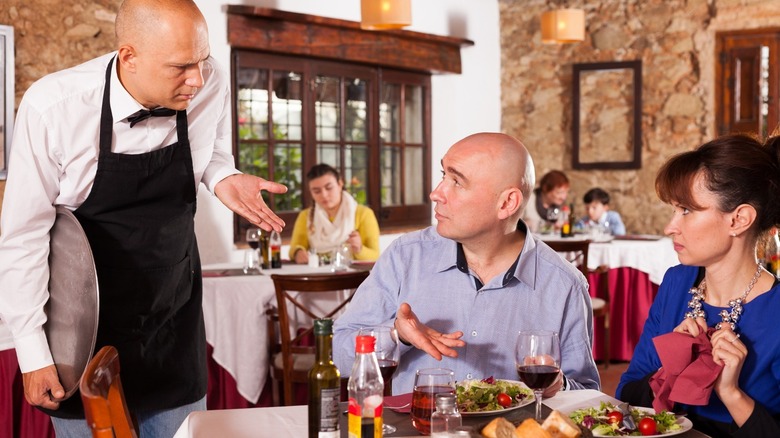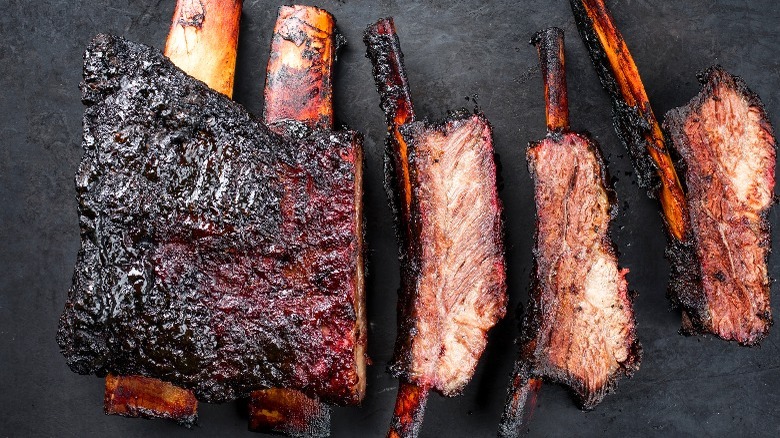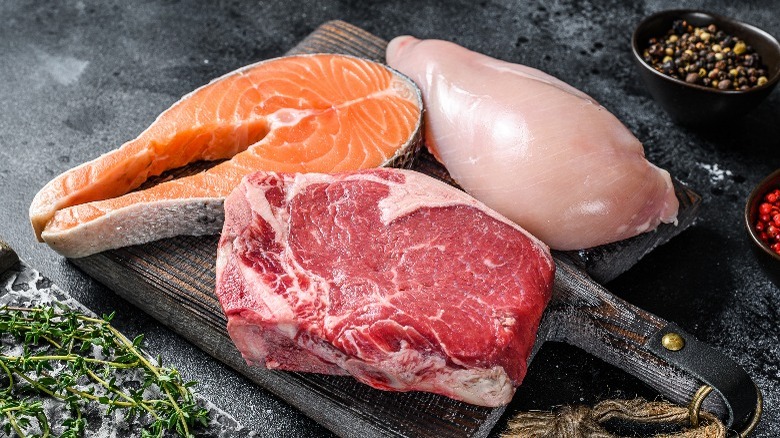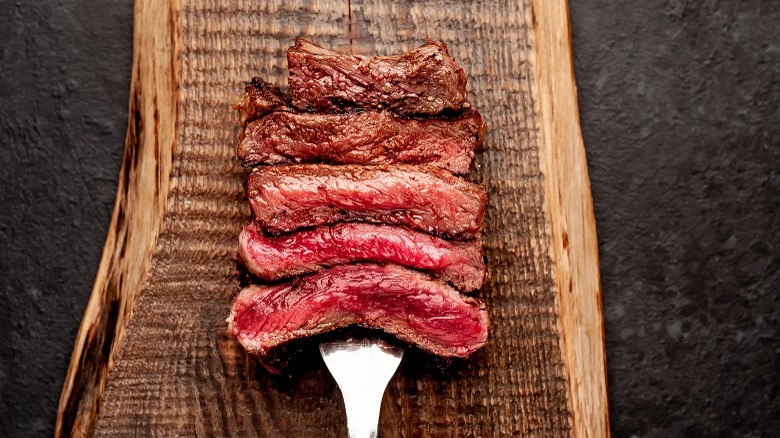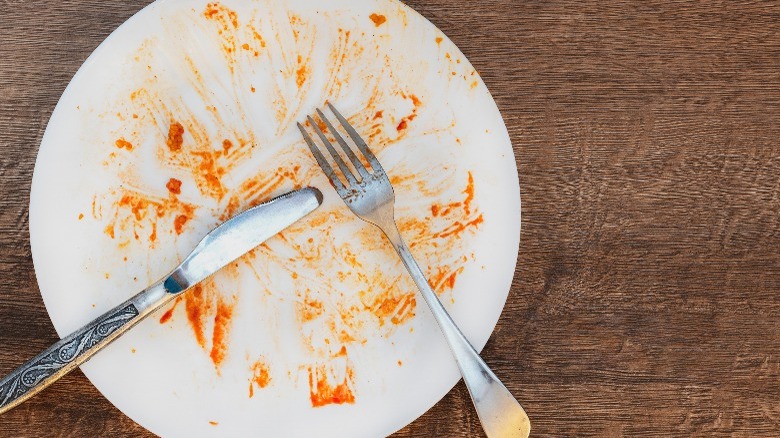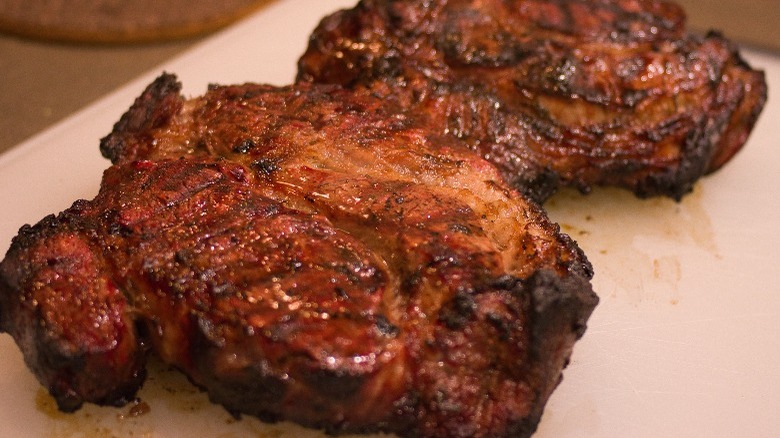11 Signs You Should Send A Dish Back At A Restaurant
If you have ever been fortunate enough to work in the service industry, you have heard the saying, "The customer is always right." The straightforward (yet, sometimes frustrating) statement can feel dull when you have dealt with customers complaining about everything under the sun.
While there are many things restaurant servers wish customers would stop doing, sending food back for silly reasons is a big one. For example, there is always a patron who claims they love exploring new foods but ends up sending their "adventurous" selection back because they didn't like what they ordered. We're sorry, but that's a big no-no. Stick to chicken next time, bro.
We especially love it when someone demands a meal be taken off the bill after they have chowed down most of their plate. There is truly nothing like watching two restaurant managers play rock, paper, scissors to see who will have to deal with a guest like that. Oh, customer service.
As a paying guest in a restaurant, it is essential to fully understand what you are ordering, including details on temperature, ingredients used, and much more. Your server should be able to explain foods and answer questions, so ask away before putting your order in. Despite all the possible requests and complaints, there are plenty of reasonable instances where sending your food back is a must. Just remember, courtesy goes a long way, and although you are being served, the employees on the other end are all human too.
Your entrée is burnt
For some, sending food back sounds like an intimidating ask, but it shouldn't be. Mistakes happen, and the cook will fix the error or make you a new meal, depending on the issue. If anything, that very line cook will save all hostility for your server.
If you have ordered something off the menu that has come back burnt, it is perfectly acceptable to send the food back. Some of the most common foods that come burned include burgers, steaks, and just about anything cooked on a hot grill. As a paying customer, you shouldn't be expected to eat something burnt to a crisp or simply inedible. You can always try a bite or two and see if you like it before politely asking your server to bring it back and request a freshly cooked entrée.
The most important thing to remember here is that there is a big difference between charred food and burnt food. Burnt food usually happens by accident, causing your meal to become overly bitter and overpowering to the fresh flavor of your dish. On the other hand, charring is done intentionally, making parts of your food slightly burnt. The taste of your meal and the subtle charred sections should balance beautifully and create a lovely flavor you can appreciate.
Many steakhouses offer char-grilled foods, so keep that in mind next time you order a fire-grilled porterhouse and receive gorgeous flame-kissed lines across your steak.
Your entrée is undercooked or raw
Eating certain raw or undercooked foods like meat and dairy products can be common sources of foodborne illness. While some home cooks might rely on firmness levels or time as indicators for fully cooked meats, it is not always the safest practice.
Restaurant cooks should be trained to use thermometers to ensure all hot entrées are cooked to a safe internal temperature, which is a simple fact of food safety.
The Centers for Disease (CDC) warns against eating raw or undercooked meat and says the only way to kill bacteria is by cooking it through. Uncooked meat and poultry can carry bacteria like E. Coli and salmonella, so if you cut into a hunk of meat and notice a translucent pink-hued appearance where there shouldn't be, consider sending it back.
Obviously, there is a caveat when it comes to ordering steaks, burgers, and sometimes even some fish like salmon or tuna. Protein options like these are foods that you can sometimes order at a temperature like medium or medium rare, depending on regulations placed by the food establishment. As long as you know, you are assuming the risks associated with consuming them. We hope you never have to deal with receiving an undercooked meat or seafood order, but mistakes happen, so politely ask your server to send it back to the kitchen if that happens.
The protein you ordered is not cooked at the right temperature
We all have our own idea of what a perfectly cooked burger or steak should be. For some, it is a flawlessly charred outer crust with a cool red center. For others, a generous amount of pink gives beef the right flavor and texture. One thing we can probably agree on is that receiving your expensive plate of food and finding it to be cooked incorrectly is disappointing. You should send back a steak that is overdone or undercooked.
The definitions of a restaurant's steak doneness and temperature differ from one establishment to another, so the responsibility of communication falls on both the server and the guest. That's why talking to your server and asking lots of questions will help guide you to ordering the correct doneness. Another thing to consider is that your definition of a medium steak might differ from how the restaurant describes and cooks its medium steak. If your steak is cooked perfectly according to the restaurant's descriptions, but you don't like how it came out, we again recommend communicating with your server.
While we're on steak and burger temps, please don't ask your server for something like "medium-plus." Adding a plus simply means that you want it cooked a tad more than medium but also slightly under medium well. It's a huge red flag for steakhouse servers that the customer is far too particular and will likely be disappointed in whatever is delivered.
You received the wrong order
When ordering your food, the server is required to write down the order in its entirety to ensure they plug the correct information into the point-of-sale (POS) system. While a quality server usually has an exceptional memory, the fast-paced multi-tasked job requires a lot of requests throughout a shift, making it difficult to remember the details of an entire order.
Now and then, a server might mistakenly place the wrong order or misinterpret a guest's request incorrectly, resulting in the wrong order coming to the table. Other times, a server may bring food to the wrong table. This can happen if a server is unfamiliar with table numbers or was told to run the food to the wrong table number. Regardless of the reason, it is understandable to send your food back if you received a completely wrong order.
Getting the wrong order can pose a much larger issue for the restaurant, so it is important to tell your server about the mishap. That wrong order you had before might be another guest's meal. That means the cooks are now required to remake not one (but two meals) all over again. That is especially no fun during the busy hours and might land a cook or two in the weeds upon other errors that pile up throughout a shift.
There is a foreign object in your meal
This might be slightly more obvious for some than others, but you should absolutely send your food back if you find a foreign object in your meal. The definition of "foreign object" can be just about anything inedible that does not belong on your plate.
Many of us know the dreaded feeling of digging into a meal only to find a hair within it. For some, the unintentional find is no big deal, but for others, it is a bit more challenging to get passed the queasiness that comes with finding a stray. While finding a stray hair in your food is no doubt unsanitary (and pretty gross), it isn't necessarily hazardous to your health. That doesn't mean you should have to continue eating the meal.
Some foreign objects you may find in your food that can be downright dangerous include things like glass, skewers, and bits of metal or plastic. We hate to say it, but we're speaking from experience here. If you find any type of nonfood object in your food, you must tell your server not only for your safety but for the safety of others.
You might have found a foreign object in your food before getting hurt, but the next guest might not be so lucky. Be sure to send your food back for a new plate and show the server the foreign object so they can bring this to their manager's attention immediately.
Your food is lukewarm or cold and shouldn't be
At some point, you are bound to receive a plate of cool or somewhat warm food when it should be piping hot or crisp and cold. Not only does this cause an unpalatable appetizer or dinner, but it can also be pretty dangerous.
Most restaurants hold hot soup on the line by placing pans in a hot bath. If the hot bath works correctly, the soup should be hotter than 140 degrees Fahrenheit to be considered safe to consume. Soups sitting at a temperature between 40 degrees and 140 degrees Fahrenheit are considered to be in the danger zone and can cause foodborne illness (via USDA).
After slurping up one or two spoonfuls of soup at a restaurant, if you find that it is simply not hot enough, then by all means, send it back. Your server can ask the cooks to nuke it for you and return it to a more suitable temperature. For some, piping hot food is simply a preference beyond the typical hot bowl.
Hot food that isn't hot enough is one thing. However, eating a limp or warm salad that should be crisp, fresh, and cold is another. If your salad comes out warm, chances are, it sat in the "window" for too long. Asking the cook to prep a new fresh (and cold) bed of greens is a quick and easy fix, so don't be reluctant to request somefresherr side.
The entrée contains an ingredient that you are allergic to
Dining out with food allergies is stressful for families, especially if it is your first visit and you don't know the menu. With common allergens like tree nuts, milk, and shellfish typically found in restaurant kitchens nationwide, someone with severe allergies is always on high alert.
One way to avoid the possibility of a reaction like anaphylaxis is by calling a restaurant ahead of time to give the chef or restaurant manager enough time to safely prepare something special. All restaurants follow specific protocols for these situations, but communicating your needs is critical.
Because most restaurant menus don't go into full detail on ingredient lists, always check about problematic ingredients before placing your order, so you can request that it be cooked without them. If the meal comes out and you notice that it contains an ingredient you are allergic to, be sure to immediately bring attention to the matter.
Politely ask that an entirely new entrée be cooked, as cross-contamination has already occurred and will still cause an allergic reaction. If you are looking for any approval on sending food back, this is the biggest one.
The plate is dirty
This might bother some more than others, but if you find that your plate is dirty, with leftover crusties from the last meal, you are more than welcome to send the food back.
High-quality sanitation is one of the most essential matters a restaurant should strive for during every shift. Wondering how to tell if a restaurant lives up to the high standards of cleanliness? Believe it or not, one of the best ways to judge how clean a restaurant is, is by checking the bathrooms. While it isn't always possible to look totally tidied during busy times, the cleanliness of dining tables, plates, and silverware should always take precedence.
Next time you order food and you notice the plate looks less than spotless, feel free to send your meal back. If it doesn't bother you so much, at the very least, you are always welcome to ask for a new, clean plate to replace the other.
The order is completely different than described
Whether you have dined at your favorite tavern a hundred times or it's your first time trying out your city's newest diner, there is something comforting about food descriptions. Sure, some restaurants (mainly local ma-and-pa spots) come with vague menu descriptions or none at all, but who really needs an explanation for a turkey club sandwich with fries?
When it comes to most dining establishments that serve lunch and dinner, you will typically find menus that include details on ingredients and how the meal is cooked. So if you have ordered the wild mushroom ravioli and it is described as "An assortment of foraged mushrooms cooked just right, mixed in with a velvety cream sauce over homemade ravioli," you would expect just that.
If, instead, you have received a sad plate of previously frozen tortellini with what appears to be a mushroom gravy made with baby Bellas, well, then you might find yourself to be a bit disappointed. If you are paying top dollar for something special, it should match the description well. If not, it is acceptable to send it back.
The steak you ordered has a lot of gristle
When ordering a high-priced meal at a restaurant, there are reasons you should and shouldn't send a steak back. A nicely marbled, well-seasoned steak shouldn't be that hard to come by, especially when ordering from a well-known steakhouse. Alas, mistakes happen, and as a paying guest, you aren't expected to eat a meal far below par. So, if you receive a steak with a ton of gristle, feel free to request a new one.
Now, let's get real here for a second. Some steaks are fattier than others, but those soft strips of fat are not gristle. So, we suggest you refrain from asking for a new steak because it is "too fatty." Instead, ask questions ahead of time and know what cut you are ordering.
Steak gristle comes from a type of connective tissue called elastin, which doesn't break down. Instead, it remains on the steak to terrorize your jaw as you persist in chewing the meat to death. Some gristle is harder to trim off — this is especially the case for bone-in steaks, so keep that in mind when ordering a porterhouse or t-bone. However, a boneless steak shouldn't have much (if any) gristle; if it does, it indicates that it was not properly trimmed, and it is understandable to request a new one.
Your order was not prepared like it usually is
If you are a regular at your favorite restaurant, there's a good chance you have a few favorite entrées you tend to order when visiting. We won't lie; it is comforting to order a meal you love, especially when you know it comes out perfectly every single time.
Unfortunately for some, an awkward moment may come when you receive your food, which is nothing like what you usually get. Perhaps a new cook is working the line, or a few ingredients were flat-out missed in the cooking process. Regardless, there is nothing wrong with politely letting your server know and sending it back to the kitchen.
Respectfully explain to your server that you have ordered that meal several times and that it just isn't the same as usual. This will not only allow them to fix the meal, but it can be a learning opportunity for the new guy (or gal) back in the kitchen. Plus, you'll receive a new and improved entrée that is just what you expected to begin with.
